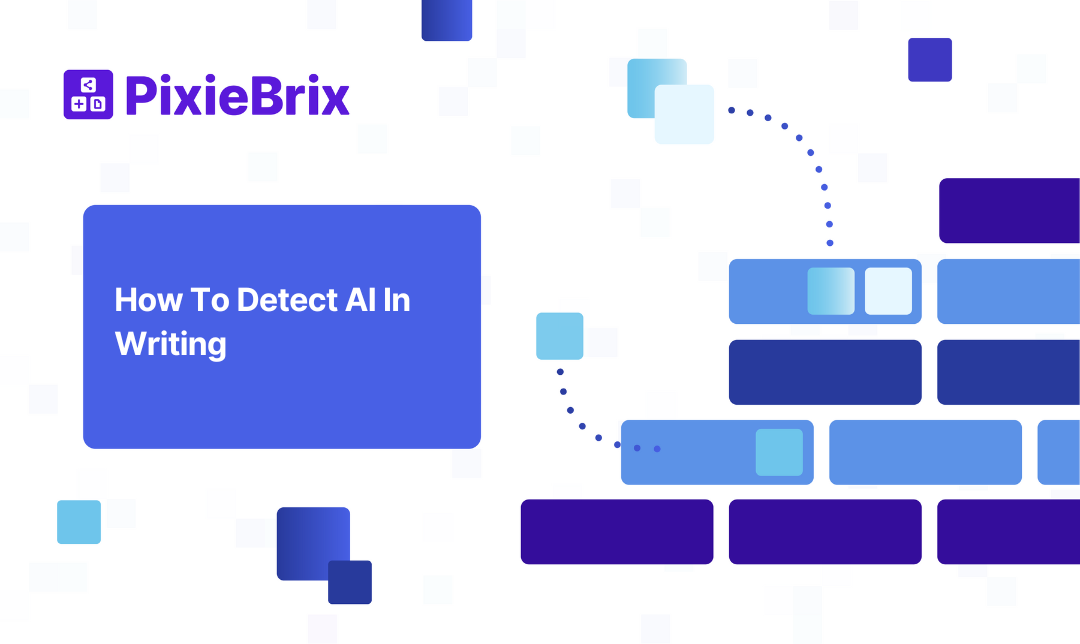How To Detect AI In Writing
How to detect AI in essays, blogs, and more. Use PixieBrix & GPTZero to highlight and analyze whether what you're reading was written by AI.

Let's face it. AI can be pretty daunting (read: terrifying). Artificial Intelligence is evolving every single day and becoming more efficient and difficult to separate from what's developed and created by humans. One major point of contention that has come to the forefront with the development of easily accessible tools is writing and how to tell if something was written by ChatGPT. Students are using free writing assistants to draft essays, salespeople are generating pitches with the aid of OpenAI text generator, and content marketers are pumping out blog posts like nobody's business with ChatGPT guiding them through the process...heck maybe a human didn't even write this blog. As tools evolve, AI-written content may soon become undetectable but there are AI plagiarism checkers out there. AI writing detectors are becoming more popular to identify AI-generated content. Here are a few key elements to explore when trying to analyze whether what you're reading was written by a human or by AI.
- Lack of emotion: While AI can be great at handling certain tasks, like answering questions on the fly or summarizing text, it can struggle with conveying emotions and personality. This can make the text feel a little bland and uninteresting. Writers might utilize undetectable ai to humanize their ChatGPT-generated content or ai paraphrasing tools, but those tools tend to go heavy on the human and light on the content.
- Repetition: When you plug in a prompt to ChatGPT's language processing AI and it spits out your paragraph, blog, thesis etc. it will likely end up sounding super repetitive, repeating similar language and phrasing. It can become very apparent as you read deeper and deeper into the piece. They end up using the same words and phrases over and over and over. Just stuck in the same pattern. Like right now. With humans, the writing is more varied as we tend to adjust our writing in that exact moment or go back and make edits. Looking for repetition is a key component in detecting AI text generation and AI content creation.
- Errors: This is a tough one and definitely more difficult to gauge whether it's a human error or just AI failing to grasp grammar, spelling, or punctuation. I'm sure I made some grammatical errors earlier in this blog, whether I forgot to drop in "are" after "there" or Grammarly just didn't catch something (though that's unlikely). A good way to gauge whether AI had written a specific piece is to refer to the author's past work and check out the grammar and punctuation to see if there's a trend that had changed recently.
- Context: As we said earlier, AI continues to evolve and grow but there are still major limitations. AI is relatively 1:1 at the moment. Meaning you drop in a prompt and it spits out your request. Human-curated content will have contextual clues and details that possibly refer to previous mentions in the content or even current events. AI cannot generate the same level of complexity and depth that humans can.
So detecting AI text can be pretty difficult. You can just eye-ball it and hope for the best or you can use PixieBrix and our AI text detection tools to detect AI writing with GPTZero.
AI Writing Detector
Our AI text detector integrates with GPTZero to quickly analyze and classify whether specific text was written by AI. All you need to do is highlight specific text, then right-click to open up the Context Menu, and click the "Detect AI writing with GPTZero" action.

Then the PixieBrix sidebar gives you an overall score indicating the likelihood of the text being written by AI, then analyzes each text to show you any specific sentences that AI might have written. This is the perfect AI proofreading tool and AI writing detection tool.
Our ChatGPT detector is Perfect for teachers analyzing student's work, content marketers reviewing submissions, bloggers grading their own work, or anyone just curious.



